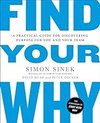
Find Your Why

end up with at least five stories that you consider the most impactful of your life. The more stories you have, the easier it will be for your partner to detect the patterns and themes that will lead to your WHY. Remember that each story must be about a specific time, place or moment.
Simon Sinek, David Mead, • Find Your Why
When it comes time to choose the stories you’ll tell your partner, choose the highest of the highs and the lowest of the lows. These are the stories that carry the most emotion and therefore the ones that will most clearly lead to your WHY.
Simon Sinek, David Mead, • Find Your Why
TO SO THAT . The contribution is the first blank and the impact is the second blank.
Simon Sinek, David Mead, • Find Your Why
there are three steps to discovering your WHY (tell stories, identify themes, draft the Why Statement). It works best when you complete all three steps in one sitting.
Simon Sinek, David Mead, • Find Your Why
In addition to the recurring themes that you’ll listen for in each story, there are two other main components to look for: contribution and impact.
Simon Sinek, David Mead, • Find Your Why
While these details are important to set context to what will be shared next, they won’t help you get to the WHY, because the WHY is connected to feelings.
Simon Sinek, David Mead, • Find Your Why
The “TO SO THAT ” format works for everyone. It’s the simplest way to codify our calling. Whether our WHY is individual or tribal, when we work with a clear WHY in mind, we show up every single day with the feeling that we are part of something bigger than ourselves. *
Simon Sinek, David Mead, • Find Your Why
The first blank represents the contribution you make to the lives of others. The second blank represents the impact of your contribution.
Simon Sinek, David Mead, • Find Your Why
By looking to our past and teasing out the most significant threads—the experiences we’ve had, the people we’ve been influenced by, the lives we’ve touched and the highs and lows we’ve faced—we can identify patterns. For individuals, our WHY is fully formed by our late teens.